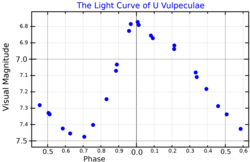| Observation data Epoch J2000 Equinox J2000 | |
|---|---|
| Constellation | Vulpecula |
| Right ascension | 19h 36m 37.7281s [2] |
| Declination | 20° 19′ 58.5692″ [2] |
| Apparent magnitude (V) | 6.73 - 7.54 [3] |
| Characteristics | |
| Spectral type | F6Iab-G2 [4] |
| Variable type | δ Cep [3] |
| Astrometry | |
| Proper motion (μ) | RA: 0.906±0.050 [2] mas/yr Dec.: −0.960±0.062 [2] mas/yr |
| Parallax (π) | 1.0530±0.0390 mas [2] |
| Distance | 3,100 ± 100 ly (950 ± 40 pc) |
| Absolute magnitude (MV) | -3.69 [5] |
| Orbit [6] | |
| Period (P) | 2,510 days |
| Eccentricity (e) | 0.675 |
| Periastron epoch (T) | 2444800 |
| Argument of periastron (ω) (secondary) | 353° |
| Semi-amplitude (K1) (primary) | 3.64 km/s |
| Details | |
| Mass | 6.5 [7] M☉ |
| Radius | 60 [7] R☉ |
| Surface gravity (log g) | 1.75 - 1.85 [8] cgs |
| Temperature | 5,655 - 5,965 [8] K |
| Metallicity [Fe/H] | 0.09 [9] dex |
| Age | 82 [9] Myr |
| Other designations | |
| BD+20° 4200, HD 185059, HIP 96458, HR 7458, SAO 87447 [10] | |
| Database references | |
| SIMBAD | data |
U Vulpeculae is a variable and binary star in the constellation Vulpecula. It is not visible to the naked eye, but can be seen with binoculars.
It is a classical Cepheid variable and its apparent magnitude ranges from 6.73 to 7.54 over a precise cycle of 7.99 days. [4] Its variable nature was discovered in 1898 at Potsdam Observatory by Gustav Müller and Paul Kempf. [11]
In 1991 a study of radial velocities showed that it U Vulpeculae is a spectroscopic binary and a full orbit with a period of 2510 days (6.9 years) was first calculated in 1996. [12] [7] The secondary star is invisible and is only known from its effect on the motion of the primary. [6]
